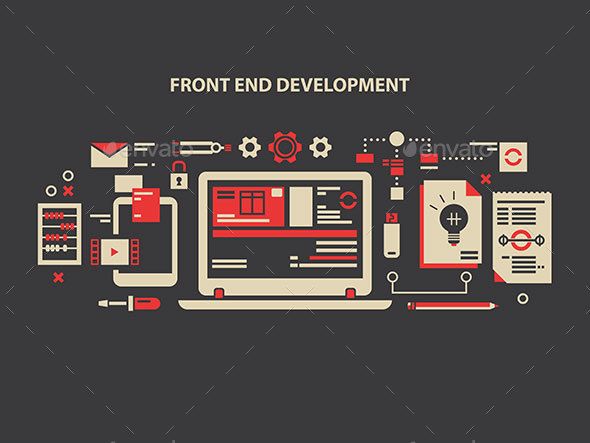
Front end Development : Master Guide to Front end Development 2024
The primary focus of front end development is users’ experiences. Utilizing corresponding designs & programming techniques that front end developers use, they develop parts of an application which are accessible to end users directly with in mind rendering an interface that is elegant simple to use quick, secure and fast encouraging user interaction & engagement.
In order to create an appealing user interface developers of front end apps typically will focus on particular aspects of design, such as color & style of text such as graphs, images, buttons, tables, as well as general colors. These design elements play significant function in increasing user experience & visual appeal of app.
Front end app development includes different interactive elements such as pop ups, sliders, as well as custom maps. crucial component of any front end application is navigational menus that provide users with guide through application improving their user experience & interactions with app or site. Making easy to use navigation menus is an essential skill for front end developers.
Front end developers need certain collection of capabilities to efficiently design user interfaces. It is must to be proficient in programming language like HTML, CSS and JavaScript in addition to an in depth comprehension of CSS preprocessors like Sass & Less. Regarding requirements for career Front end developers who want to work in field typically take course from Computer Science or related discipline, though it’s not necessarily necessity. ability to comprehend basics & ability to code in language like HTML, CSS, JavaScript & more recently jQuery language are crucial.
In addition, having solid knowledge about server side CSS processing methods & their application for web development can be advantageous. When it comes to CSS front end developers need to be skilled in designing text & selecting suitable colors & designs for better readability & interaction with users. Additionally, they should be adept in TypeScript which is subset of JavaScript that adds capabilities for static typing to language.
With most up to date technological & design trends that are geared to front end that allow you to create advanced designs & interactivity patterns. However, at same time, greater complicated results, so that front end development has evolved into specialist area that requires deep understanding.
The front end, often called”the “client side” of an application, are ones that users interact with & see. They are distinct from backend which is invisible machines in background. For this reason, APIs serve as translators, to ensure seamless communications between user interface as well as back end that is complex.
The main trend that has characterized front end development of recent times is increase in applications that are designed for smart & mobile devices & users using applications on variety of mobile devices, with different size screens & different interaction options. This means front end developers have to make sure that application provides an identical, top quality experience to users across all kinds of devices & user situations. It’s an enormous task.
Front End Development Versus Back End Development

Hardware, computer programs & websites are comprised of many elements such as databases, code as well as user’s interface (UI). These that communicate with users take place at front end. those who operate technology reside at backend, often known as data access layer. back end supplies necessary resources for front part.
The development of front end applications is focused on front end interfaces, back end programming is concerned activities that happen in background. perception is as being technically simpler than complexity that back end developers face, which demands thorough understanding of programming language & algorithms, such as Data Structures & Algorithms (DSA) & ability to manage data.
The key distinctions between software development on front & backend development:
- The development of Backend is procedure of building elements for running applications behind scenes. Examples include components for information storage & infrastructure & integration with other systems & programming that is written in one or more programming languages. It is not possible for users to access server side.
- Front end design is method of creating components that communicate with user. Examples include an interface for users, button web pages, data entered by users as well as user experience (UX) functions. front end focuses on fulfilling requirements of users while delivering an enjoyable user experience.
One of latest concepts in front end development is that of use of micro frontends. This method involves separating development of front end apps into manageable, smaller parts to ensure better scaling & ongoing maintenance. Furthermore, front end developers must be proficient using tools to test & code analysis in order to assure that application is of high quality & performs well. app.
In order to develop their careers prospective front end developers must concentrate on creating an online portfolio of their talents & work. In addition, developing soft skills of collaboration & communication is just as crucial as technical expertise.
Programming Languages for Front End Web Development

Here are most popular programming languages used to create front end.
HTML
It is HyperText Markup Language (HTML) programming language, which outlines format & content of web content. It’s foundational element for Web development that is front end. With HTML browsers show texts or load elements rendering web pages, that contain hyperlinks, as well as hyperlinks to other pages to users.
CSS
Cascading style sheets (CSS) is most widely used language used to define way to present HTML content, including fonts, background & foreground colors and so on. By using CSS it is possible to manage layout design as well as components it uses for different gadgets like tablets, desktops as well as smartphones. components that are included include body, header & footer sections, as well as content asides & sections.
JavaScript
JavaScript (JS) expands web pages over HTML as well as CSS. Through JS:
- The web pages can be refreshed dynamically & react to user input without reloading page or making other adjustments.
- It is possible to create animated UI components like slideshows of images, pop ups as well as extensive menus for navigation.
Average Salary for Front End Web Developers
The United States, front end developers have an average annual income of $90,345, according to data provided by Glassdoor. This includes base pay of $83,119 and an additional pay of $7,226, that can be derived from variety of sources, like commissions, profit sharing & bonuses. Things like education background, job experience & professional credentials could affect pay for front end developers.
Responsive Web Development
This is question that’s frequently asked: ” What Is responsive web development?” RWD, sometimes referred to as responsive design is method of web design that focuses on the user satisfaction. goal is to provide same rendering experience for websites on different screens, devices as well as windows of various sizes & shapes. This approach is becoming essential due to increase in smartphones, with bulk of websites being accessed by mobile users. Actual examples of RWD exist, which majority of users who concentrate exclusively on speed & convenience of web pages are not aware of.
There are variety of ways in how to create websites that are flexible to different situations:
- Grids that are flexible. Grids are typical design tool that is used for creating websites. Websites that are responsive require flexible grid, which can be loaded with different methods, depending on size of window or screen dimension.
- Breakpoints. Similar to flexible grids, breakpoints are points in webpage that indicate cutting points to ensure that content moves on display. Many websites include breakpoints. But minimum number should be between three & match three common devices kinds.
- Prioritization. Effective designs usually put most significant photos & data higher on page to ensure that users see them first. This is particularly essential for responsive websites since smaller screens show only small portion of webpage at any given moment. It is important to prioritize most crucial elements in order to keep people on mobile devices engaged.
- Images that are flexible. Images are often more difficult to adapt to various sizes of screens than simple text. Web designers utilize range of methods to make sure that their websites present images correctly on various displays. In some cases, screen may crop portion of an image to make an improved proportion to. If there are multiple different versions of an image for web site you can choose which version which will be rendered based on display size or type of device.
- Responsive media queries. They are code commands which determine minimum & maximum dimensions of media assets and define orientation of their assets. In end, majority of media files in website are loaded at correct dimension.
- The mouse & other touchscreen friendly components. Desktop users are proficient with their mouse however, certain actions may be more challenging to use for mobile users. responsive websites should be able to accommodate phones by ensuring that every step is accessible via touchscreen. Links should be big & easy to read on screens with small sizes & scrolling needs to be fast across all types of smartphones. Test your user experience in order to confirm that all elements function effectively on various devices.
Front End Development Frameworks

Front end frameworks offer premade components & codes including routinely written standard functions, packaged in libraries. You don’t have to create common functionality or components by hand.
They often incorporate drag & drop elements that allow developers to create attractive layouts as well as apps that have variety of built in functions effectively.
Angular
Utilizing Angular an incredibly popular open source JavaScript framework that was initially developed by Google it is able to deliver high quality results with HTML syntax. Angular uses modular design & adheres to MVC structure, which breaks down structure of website into three distinct parts which are view, model as well controller (MVC). It is particularly notable that Angular allows cleaner code by using TypeScript & makes use of dependency injection design model.
React
It was first introduced in 2011 by Meta & supported now by wide community of users, React is free that is declarative JavaScript framework that uses component based method of development. allows reuse of code. React allows for more effective updates of pages using an underlying virtual document Object Model (VDOM), an extremely lightweight JavaScript model of DOM that improves speed. React can be used React to create single page apps (SPAs).
jQuery
It is widely used & is used by variety of plugins created by users, jQuery is an open source JavaScript library which simplifies creation of web based applications. It alters CSS properties through incorporation of JavaScript functions & applying effects like fade in & fade out on web pages & other elements. Through jQuery you can reduce time spent creating HTML DOM adjustments such as event handling & Asynchronous JavaScript as well as XML (Ajax).
Vue.Js
Created using JavaScript, Vue.js is base library that concentrates solely on view layer which allows creation of web interfaces that are distinct & single page apps. It is possible to integrate library along with various other libraries & tools to produce output you want.
Bootstrap
A well known, open source framework that allows you to create mobile friendly & responsive websites. Bootstrap includes JavaScript & CSS based templates with components such as bar navigation, progress bars, thumbnails & dropdowns that you can integrate into web pages.
Bootstrap makes dynamic images by implementing code in built in which automatically adjusts size of images depending on size of screen. Furthermore, by using JQuery plugins included in Bootstrap you are able to build & provide interactive solutions to animated carousels of images, modal popups & even changes.
Semantic UI
A well documented framework to create responsive layouts using HTML SemanticUI is based on semantic languages to aid in development and provides elements for various functions. It is possible to integrate Semantic UI with many third party software & applications.
Svelte
Svelte is program that transforms declarative components to highly optimized vanilla JavaScript which surgically update DOM when it’s in building phase of development. This is distinct approach to frameworks such as Vue & React that operate in browsers used by users when application is running.
Preact
Preact is light VDOM abstraction, which registers real event handlers, draws on solid platform capabilities & is compatible with various libraries. It is possible to use Preact directly within browsers, without any transpilations.
It’s so lightweight that developer’s code is one of most important components in program. This means there’s much less JavaScript to download, interpret & run, which frees time to do other things.
Ember.js
Ember.js is free of cost JavaScript framework to create huge web applications that are client side with well organized & structured code that conforms in MVC model. It uses route as its model & an underlying handlebar template to view & also uses controllers to modify data within model.
[…] Performance: a reliable algorithm must be able to perform its work efficiently and with minimal effort. […]